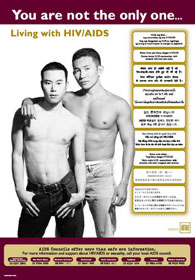Read part 1 here.
What is the rest of the world doing about it?
There are simply too many examples of pragmatic public health policies and successful intervention from all over the world. I will quote only a selected few here:

Developed by the Australian Federation of AIDS Organisations (AFAO) in 1998, the above poster was part of a wider campaign designed to increase the visibility of HIV positive Asian gay men, to raise awareness of HIV+ gay Asian men's needs in the gay and lesbian community, the positive community and the broader Asian community and to challenge discriminatory attitudes within these communities.
In Brazil: "One of the primary missions of Brazil's National STD/AIDS program (NSAP) is to make HIV medications available free of charge to all citizens who need them through the country's public health care system. This effort was initiated in the early 1990's with limited distribution of the AZT capsule, and was strengthened with a 1996 presidential decree that guaranteed that all HIV-infected citizens would have free access to essential medication to combat HIV. The distribution of protease inhibitors began between December 1996 and January 1997." (AIDS drugs policy - Ministry of Health Brazil)
In Thailand: "The National Human Rights Commission will propose a bill to provide basic human rights protection to more than 500,000 people living with HIV/AIDS. It is hoped the law will ensure fairer treatment and better understanding for people suffering from the disease which is transmitted mainly via sexual activity and drug use." (Wipatayontin 2006)
In Vietnam: Peer educators among the highly mobile construction workers in Ho Chi Minh City were empowered to help spread safe sex norms. The study found that they "were able to reach a higher proportion of the workers than the visiting health communicators; they had a lower dropout rate; and the cost per person contacted was lower than that of the visiting health communicators. Sexual values of the construction workers improved significantly in the peer educator sites only. And finally, a diffusion effect in the peer educator intervention sites occurred among workers not directly exposed to the education activities." (U.S. Agency for International Development 2003)
In Tanzania: "... teachers and health worker implemented a two-to-three-months program of AIDS-related information, small group discussions, and role-play to improve primary-school-age children's knowledge, attitude and practices. Follow-up 12 months later show that attitudes towards people living with HIV/AIDS had significantly improved" (UNAIDS 2002, Klepp et al 1997).
In Nigeria, evaluation of "HIV prevention education for high school students" showed "delayed initiation of sexual intercourse, reduced number of sex partners, and increased use of condoms." (Alford, Cheetham, Hauser 2005)
What can we do?
Both the government and the people can do many things to counter stigma in Singapore. There are three things that citizens can do immediately:
The first is for everyone to talk to your family, friends, MP and Ministers. Tell them that stigmas do exist in Singapore; that they exact huge social costs and we need to stop it. Tackle each of the stigmas concretely. For example, if you have a friend who has teenager children, talk to them about teenage sexuality, the lack of safe-sex education in school and the need for parents to fill in that gap themselves now. Talk to as many people as you can, and in turn, ask them to talk to their friends, family, MP and Ministers as well. Talking to one another is the first and most critical step towards change.
Second, civil society groups such as AWARE or AfA can continue to launch de-stigmatising campaigns even though no other PLWHA wants to come out. The experience of Asian & Pacific Islander Wellness Center in the San Francisco Bay Area shows that when people around the PLWHA "come out" about their relationships to and support of PLWHA, it is even more powerful. John Manzon-Santos, executive director of Asian & Pacific Islander Wellness Center, puts it this way:

UCLA AIDS Institute: ''Elizabeth Taylor [who co-stared with Rock Hudson in Giant, 1956, above] is recognised as the Joan of Arc of AIDS activism. It has been twenty years since Dame Elizabeth took the hand of the dying Rock Hudson - on camera, before the whole world - and, through that single, simple, humane and heroic gesture, brought the agony of AIDS into the light. She has kept the world's attention focused on the HIV pandemic ever since, by turning the public's insatiable curiosity about her into an immensely effective vehicle for her essential message - which is that the epidemic will not end until there is a cure.''
There is no need to wait for another Paddy Chew in Singapore. We should instead focus our energy on persuading the people around our Singaporean PLWHAs to come out and help their loved ones. If it is too difficult for family members to come out, then friends, co-workers and caregivers can take the lead. If de-stigmatising PLWHA is too difficult to get pass government censors, then work first on addressing the stigmas faced by the family when one of their members is HIV+. Even if this might play into the "innocent victims" discourse, exercising care in the choice of the message can mitigate this risk.
Finally, civil society groups need to collaborate to address each of the HIV-related stigma. Women's groups like AWARE are already tackling sexism and sex phobia. Gay and lesbian groups are already tackling homophobia. Why not collaborate and address these stigmas together? New partners among healthcare professionals need to come forward and add their voice more prominently against the stigma surrounding disease and death, as well as against the other stigmas. Everyone can also address the state-imposed stigma surrounding civil society organisation. Local religious leaders have been appearing for many years at the annual vigil on World AIDS Day organised by AfA. Instead of just reciting a prayer once a year in a park, why not persuade religious leaders who believe in compassion to speak up during the other 364 days of the year about compassion towards our fellow human being? In doing this work, we need to realise that it is not just narrowly focused on HIV/AIDS, but is part of a larger process to make Singapore a better place for everyone.
There are also many things that the government can do. First, it can collaborate with local NGOs to create a non-discrimination best practices brochure. Second, it can take the lead and either mandate or encourage all ministries and government-linked companies to undergo an HIV/AIDS education that includes a de-stigmatisation component. Third, key officials such as the Prime Minister can speak and personally demonstrate non-judgmental compassion for PLWHA. Fourth, it can run or fund the running of a national de-stigmatisation campaign, or at the very least stop banning privately funded campaigns. Finally and most crucially, it can review which of the current policies are discriminatory and implement new ones.
Before concluding this essay, I want to discuss one important piece of experience gained by HIV agencies in the USA: general messages are much less effective than targeted messages in promoting safer sex. It is very important to run focus groups and personal interviews to find out the social norms that drive unsafe sex among various groups, e.g., youths, gay men, unregistered sex workers, etc. These focus groups can also give feedback on the effectiveness of public messaging that targets their communities and help design more effective messages.
Given the strength of stigmas in Singapore, people will be more willing to tell the truth if the person doing the study is from their own community. Thus, we must empower PLWHAs and collaborate with them. They can help in the studies by volunteering to lead the focus groups and conduct personal interviews.
Conclusion
There is no shame for the government and society to go through the stages of denial, blame, and punishment with regards to HIV/AIDS. Most other countries in the world went through similar stages. As early as 1987, Mann has already pointed out that stigma, discrimination, blame and collective denial were potentially the most difficult aspects of the HIV and AIDS epidemics to address, but also that addressing them was key to overcoming it (Mann 1987, Nyblade et al 2003). What is important now is how quickly each country recognises their own prejudices for what they are and finds the moral courage to adopt pragmatic public health policy solutions to stop the spread of this disease.
To quote a noted researcher, Prof Parker of Columbia University: "The most effective and powerful responses to the epidemic have taken place precisely when affected communities have mobilized themselves to fight back against stigmatization and oppression in relation to their lives" (Parker & Aggleton 2003, Altman 1994, Daniel & Parker 1993, Epstein1996, Parker et al 1995, Stoller 1998). For affected communities to mobilise in Singapore, there is an urgent need to tackle the state-imposed stigma against advocacy work.
Many countries in all regions of the globe have already made the transition and showing encouraging results in their fight against HIV/AIDS. The Singapore people need to decide if this is an issue that they can ignore and leave it to the government to handle, or to become empowered and do something about it themselves. The Singapore government will need to decide if it wants its public health response to HIV/AIDS to be about ideology, or about effective intervention. This is an urgent question because every day we wait and give in to irrational emotional responses disguised as high moral standards, the more we risk people dying prematurely and the virus becoming intractable.
Acknowledgement
I would like to thank my research assistants, Nurhaizatul Jamila Bt Jamil for searching and organising news articles from the local media, and Amutha Meyyappan for accessing and photocopying books and journal articles. I would also like to thank Prof Khoo Hoon Eng and Prof Roy Chan for reading and commenting on the initial drafts.
Footnotes and references for this essay can be viewed in PDF format by clicking here.
Dr Tan Chong Kee holds a Ph.D. in Chinese Literature from Stanford University in the United States and is one of Singapore's best-known figures in civil society activism.
